Business Analysis of Tesco: Micro Analysis, Logistics, Value Chain
VerifiedAdded on 2022/08/09
|18
|4109
|357
Report
AI Summary
This report offers a comprehensive business analysis of Tesco, a leading international retail company. It begins with an introduction to Tesco's background, products, and services. The core of the analysis involves a detailed application of Porter's Five Forces, assessing the threat of new entrants, bargaining power of suppliers and buyers, threats of substitutes, and rivalry among competitors, providing valuable insights into Tesco's competitive environment. The report then delves into Tesco's inbound and outbound logistics, operational processes, and secondary activities, including human resource management and technology development. A value chain analysis is also conducted to identify key value-adding activities. Finally, the report summarizes the findings, reflecting on Tesco's competitive advantages, cost reduction strategies, and economic efficiencies, providing a holistic view of the company's business operations and strategic positioning within the retail industry.
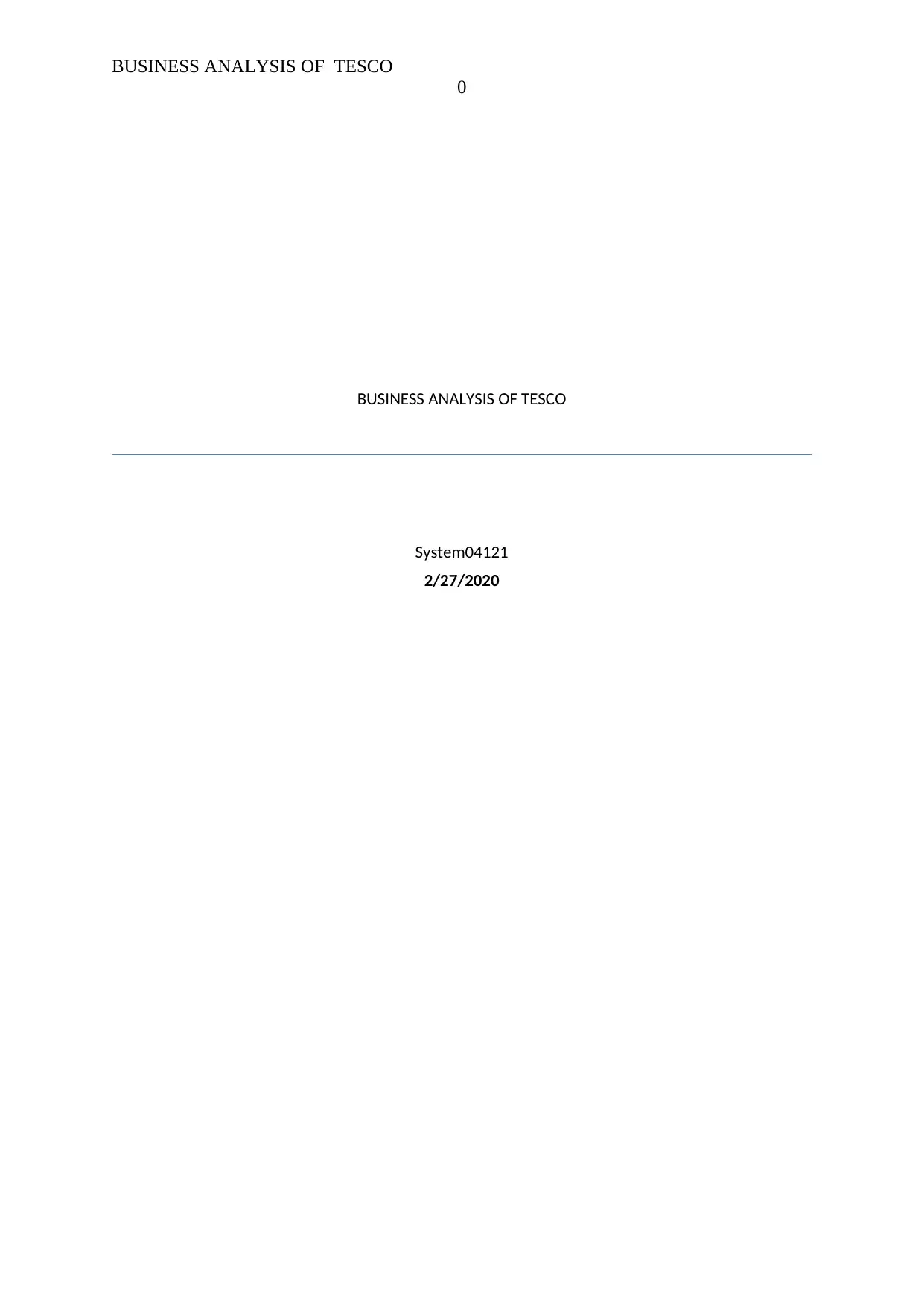
BUSINESS ANALYSIS OF TESCO
0
BUSINESS ANALYSIS OF TESCO
System04121
2/27/2020
0
BUSINESS ANALYSIS OF TESCO
System04121
2/27/2020
Paraphrase This Document
Need a fresh take? Get an instant paraphrase of this document with our AI Paraphraser
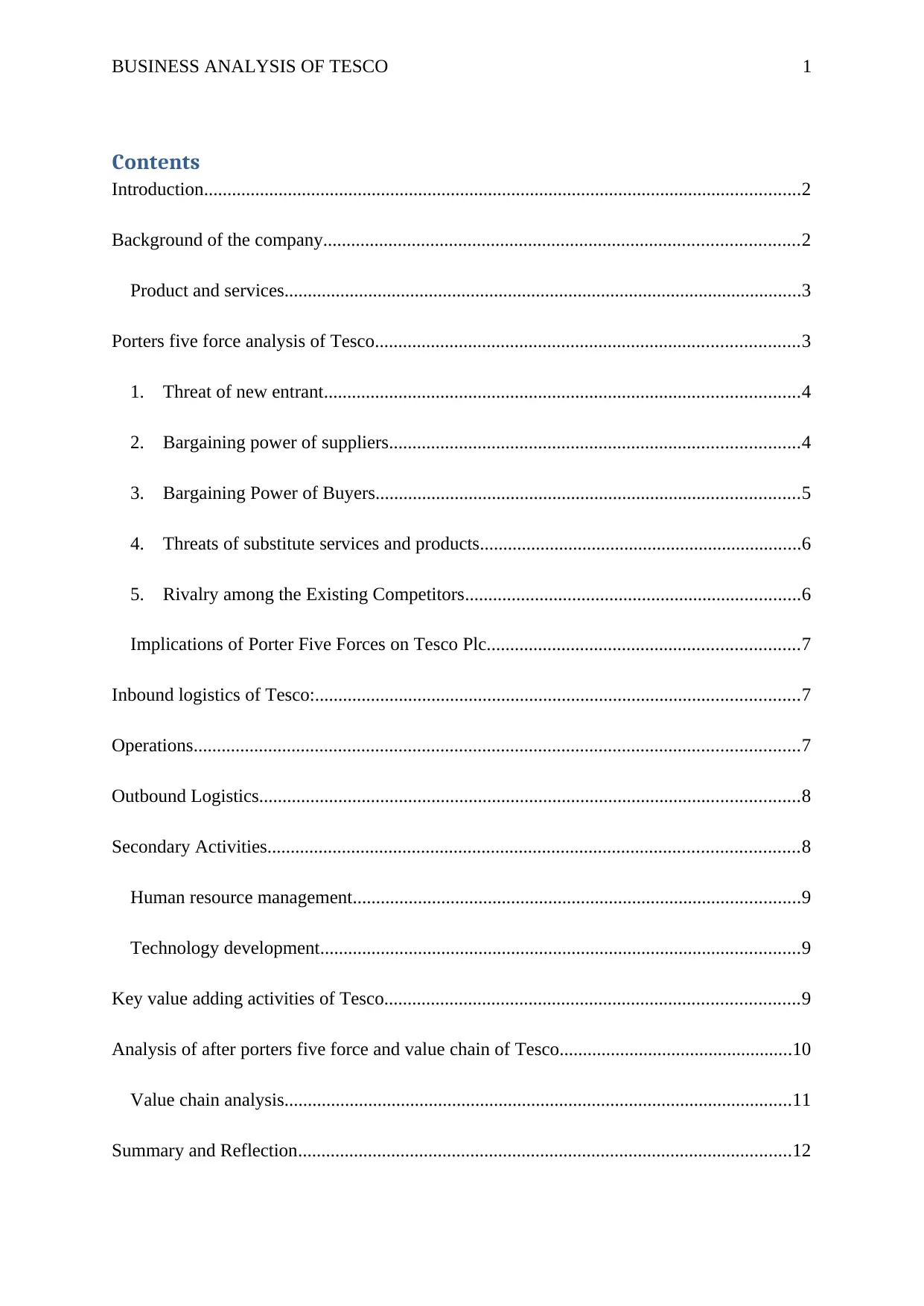
BUSINESS ANALYSIS OF TESCO 1
Contents
Introduction................................................................................................................................2
Background of the company......................................................................................................2
Product and services...............................................................................................................3
Porters five force analysis of Tesco...........................................................................................3
1. Threat of new entrant......................................................................................................4
2. Bargaining power of suppliers........................................................................................4
3. Bargaining Power of Buyers...........................................................................................5
4. Threats of substitute services and products.....................................................................6
5. Rivalry among the Existing Competitors........................................................................6
Implications of Porter Five Forces on Tesco Plc...................................................................7
Inbound logistics of Tesco:........................................................................................................7
Operations..................................................................................................................................7
Outbound Logistics....................................................................................................................8
Secondary Activities..................................................................................................................8
Human resource management................................................................................................9
Technology development.......................................................................................................9
Key value adding activities of Tesco.........................................................................................9
Analysis of after porters five force and value chain of Tesco..................................................10
Value chain analysis.............................................................................................................11
Summary and Reflection..........................................................................................................12
Contents
Introduction................................................................................................................................2
Background of the company......................................................................................................2
Product and services...............................................................................................................3
Porters five force analysis of Tesco...........................................................................................3
1. Threat of new entrant......................................................................................................4
2. Bargaining power of suppliers........................................................................................4
3. Bargaining Power of Buyers...........................................................................................5
4. Threats of substitute services and products.....................................................................6
5. Rivalry among the Existing Competitors........................................................................6
Implications of Porter Five Forces on Tesco Plc...................................................................7
Inbound logistics of Tesco:........................................................................................................7
Operations..................................................................................................................................7
Outbound Logistics....................................................................................................................8
Secondary Activities..................................................................................................................8
Human resource management................................................................................................9
Technology development.......................................................................................................9
Key value adding activities of Tesco.........................................................................................9
Analysis of after porters five force and value chain of Tesco..................................................10
Value chain analysis.............................................................................................................11
Summary and Reflection..........................................................................................................12
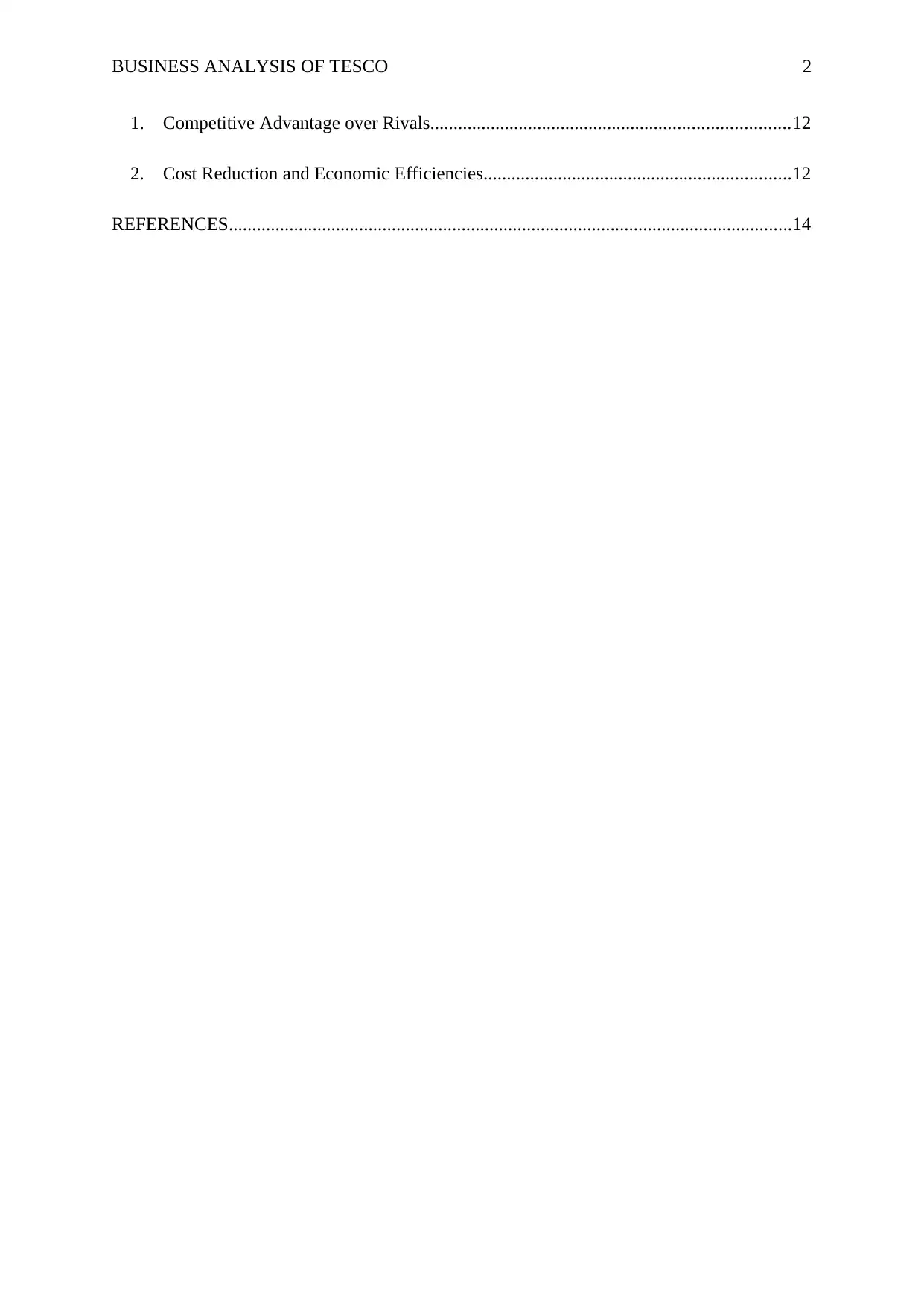
BUSINESS ANALYSIS OF TESCO 2
1. Competitive Advantage over Rivals.............................................................................12
2. Cost Reduction and Economic Efficiencies..................................................................12
REFERENCES.........................................................................................................................14
1. Competitive Advantage over Rivals.............................................................................12
2. Cost Reduction and Economic Efficiencies..................................................................12
REFERENCES.........................................................................................................................14
⊘ This is a preview!⊘
Do you want full access?
Subscribe today to unlock all pages.

Trusted by 1+ million students worldwide
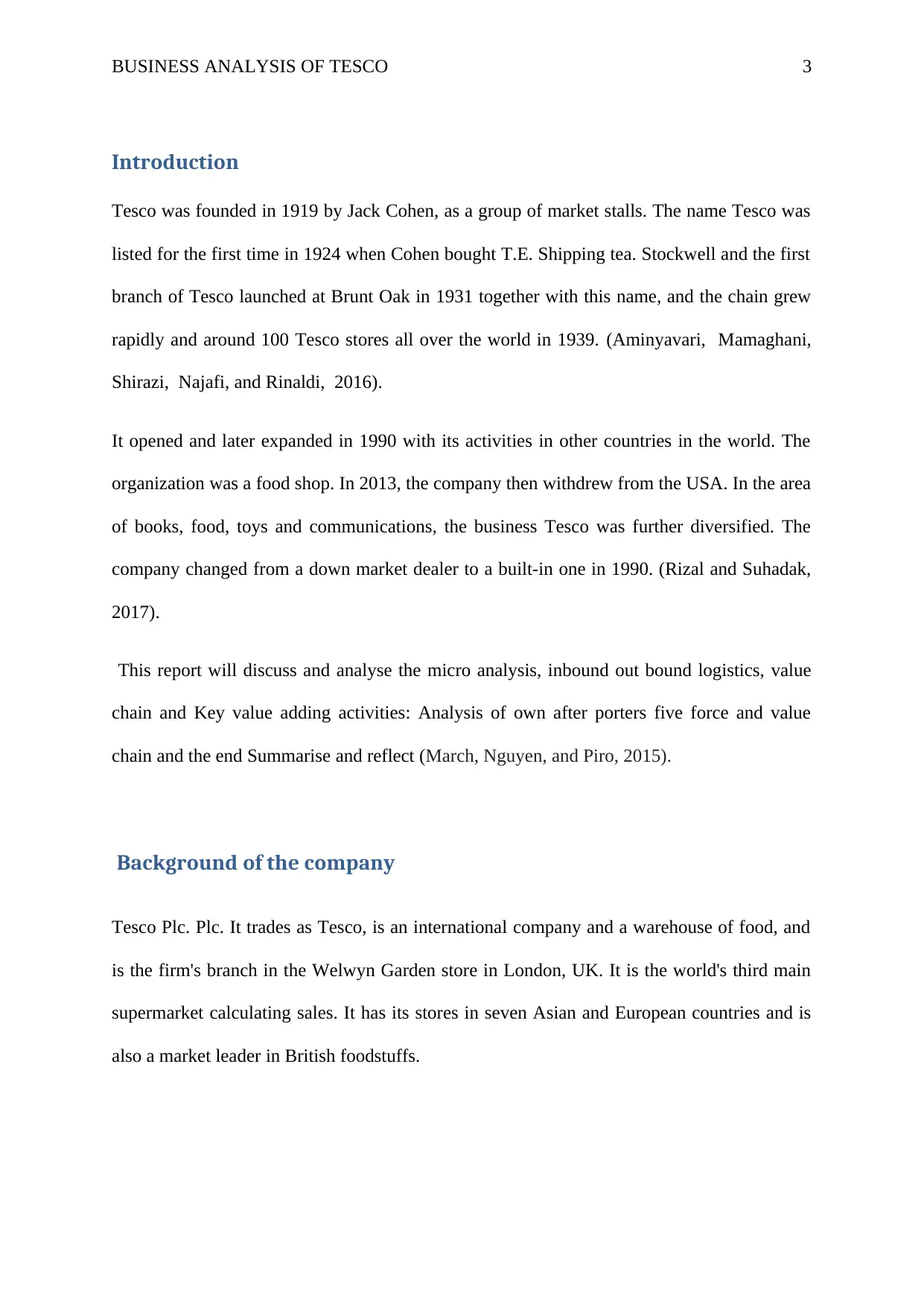
BUSINESS ANALYSIS OF TESCO 3
Introduction
Tesco was founded in 1919 by Jack Cohen, as a group of market stalls. The name Tesco was
listed for the first time in 1924 when Cohen bought T.E. Shipping tea. Stockwell and the first
branch of Tesco launched at Brunt Oak in 1931 together with this name, and the chain grew
rapidly and around 100 Tesco stores all over the world in 1939. (Aminyavari, Mamaghani,
Shirazi, Najafi, and Rinaldi, 2016).
It opened and later expanded in 1990 with its activities in other countries in the world. The
organization was a food shop. In 2013, the company then withdrew from the USA. In the area
of books, food, toys and communications, the business Tesco was further diversified. The
company changed from a down market dealer to a built-in one in 1990. (Rizal and Suhadak,
2017).
This report will discuss and analyse the micro analysis, inbound out bound logistics, value
chain and Key value adding activities: Analysis of own after porters five force and value
chain and the end Summarise and reflect (March, Nguyen, and Piro, 2015).
Background of the company
Tesco Plc. Plc. It trades as Tesco, is an international company and a warehouse of food, and
is the firm's branch in the Welwyn Garden store in London, UK. It is the world's third main
supermarket calculating sales. It has its stores in seven Asian and European countries and is
also a market leader in British foodstuffs.
Introduction
Tesco was founded in 1919 by Jack Cohen, as a group of market stalls. The name Tesco was
listed for the first time in 1924 when Cohen bought T.E. Shipping tea. Stockwell and the first
branch of Tesco launched at Brunt Oak in 1931 together with this name, and the chain grew
rapidly and around 100 Tesco stores all over the world in 1939. (Aminyavari, Mamaghani,
Shirazi, Najafi, and Rinaldi, 2016).
It opened and later expanded in 1990 with its activities in other countries in the world. The
organization was a food shop. In 2013, the company then withdrew from the USA. In the area
of books, food, toys and communications, the business Tesco was further diversified. The
company changed from a down market dealer to a built-in one in 1990. (Rizal and Suhadak,
2017).
This report will discuss and analyse the micro analysis, inbound out bound logistics, value
chain and Key value adding activities: Analysis of own after porters five force and value
chain and the end Summarise and reflect (March, Nguyen, and Piro, 2015).
Background of the company
Tesco Plc. Plc. It trades as Tesco, is an international company and a warehouse of food, and
is the firm's branch in the Welwyn Garden store in London, UK. It is the world's third main
supermarket calculating sales. It has its stores in seven Asian and European countries and is
also a market leader in British foodstuffs.
Paraphrase This Document
Need a fresh take? Get an instant paraphrase of this document with our AI Paraphraser
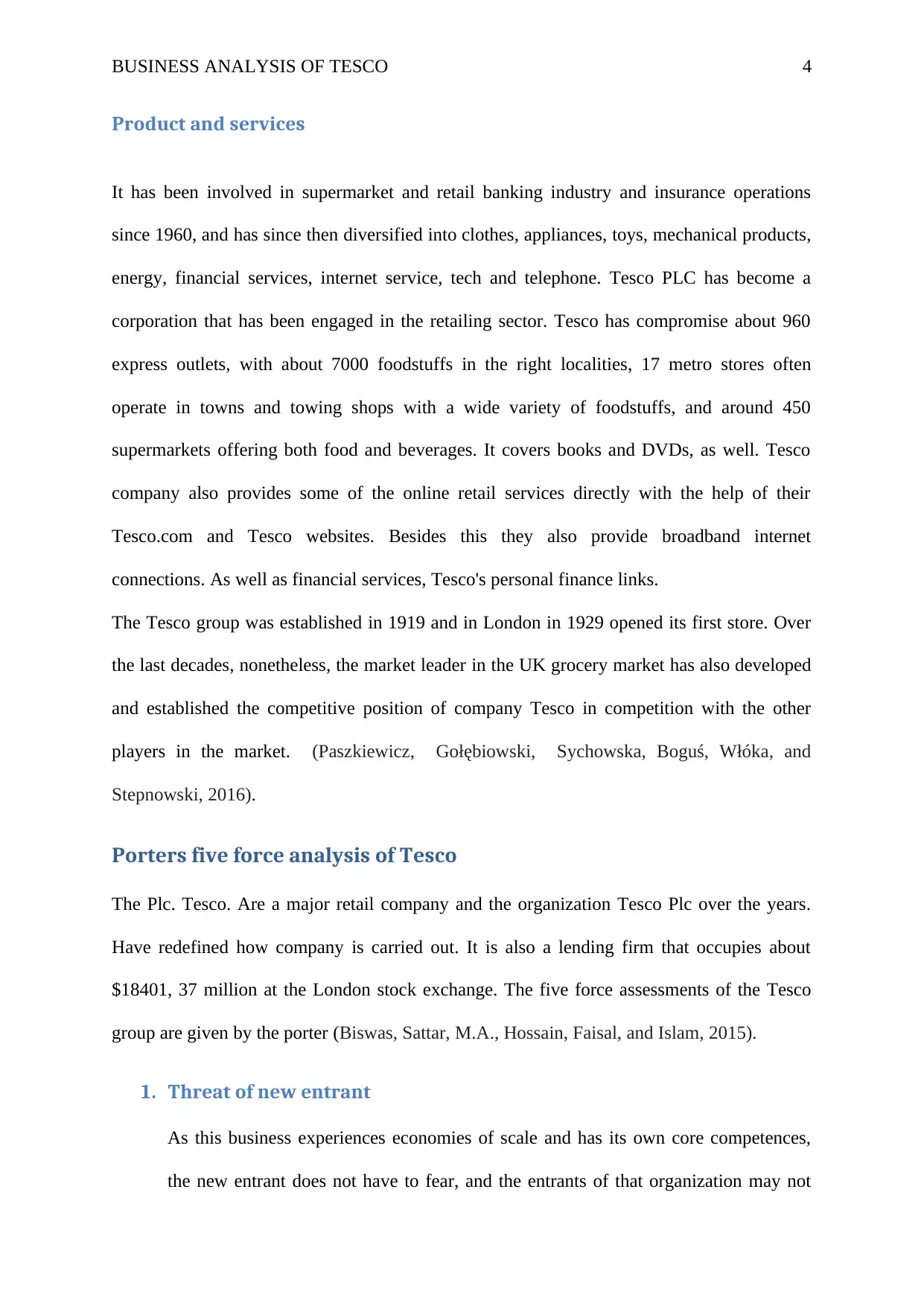
BUSINESS ANALYSIS OF TESCO 4
Product and services
It has been involved in supermarket and retail banking industry and insurance operations
since 1960, and has since then diversified into clothes, appliances, toys, mechanical products,
energy, financial services, internet service, tech and telephone. Tesco PLC has become a
corporation that has been engaged in the retailing sector. Tesco has compromise about 960
express outlets, with about 7000 foodstuffs in the right localities, 17 metro stores often
operate in towns and towing shops with a wide variety of foodstuffs, and around 450
supermarkets offering both food and beverages. It covers books and DVDs, as well. Tesco
company also provides some of the online retail services directly with the help of their
Tesco.com and Tesco websites. Besides this they also provide broadband internet
connections. As well as financial services, Tesco's personal finance links.
The Tesco group was established in 1919 and in London in 1929 opened its first store. Over
the last decades, nonetheless, the market leader in the UK grocery market has also developed
and established the competitive position of company Tesco in competition with the other
players in the market. (Paszkiewicz, Gołębiowski, Sychowska, Boguś, Włóka, and
Stepnowski, 2016).
Porters five force analysis of Tesco
The Plc. Tesco. Are a major retail company and the organization Tesco Plc over the years.
Have redefined how company is carried out. It is also a lending firm that occupies about
$18401, 37 million at the London stock exchange. The five force assessments of the Tesco
group are given by the porter (Biswas, Sattar, M.A., Hossain, Faisal, and Islam, 2015).
1. Threat of new entrant
As this business experiences economies of scale and has its own core competences,
the new entrant does not have to fear, and the entrants of that organization may not
Product and services
It has been involved in supermarket and retail banking industry and insurance operations
since 1960, and has since then diversified into clothes, appliances, toys, mechanical products,
energy, financial services, internet service, tech and telephone. Tesco PLC has become a
corporation that has been engaged in the retailing sector. Tesco has compromise about 960
express outlets, with about 7000 foodstuffs in the right localities, 17 metro stores often
operate in towns and towing shops with a wide variety of foodstuffs, and around 450
supermarkets offering both food and beverages. It covers books and DVDs, as well. Tesco
company also provides some of the online retail services directly with the help of their
Tesco.com and Tesco websites. Besides this they also provide broadband internet
connections. As well as financial services, Tesco's personal finance links.
The Tesco group was established in 1919 and in London in 1929 opened its first store. Over
the last decades, nonetheless, the market leader in the UK grocery market has also developed
and established the competitive position of company Tesco in competition with the other
players in the market. (Paszkiewicz, Gołębiowski, Sychowska, Boguś, Włóka, and
Stepnowski, 2016).
Porters five force analysis of Tesco
The Plc. Tesco. Are a major retail company and the organization Tesco Plc over the years.
Have redefined how company is carried out. It is also a lending firm that occupies about
$18401, 37 million at the London stock exchange. The five force assessments of the Tesco
group are given by the porter (Biswas, Sattar, M.A., Hossain, Faisal, and Islam, 2015).
1. Threat of new entrant
As this business experiences economies of scale and has its own core competences,
the new entrant does not have to fear, and the entrants of that organization may not
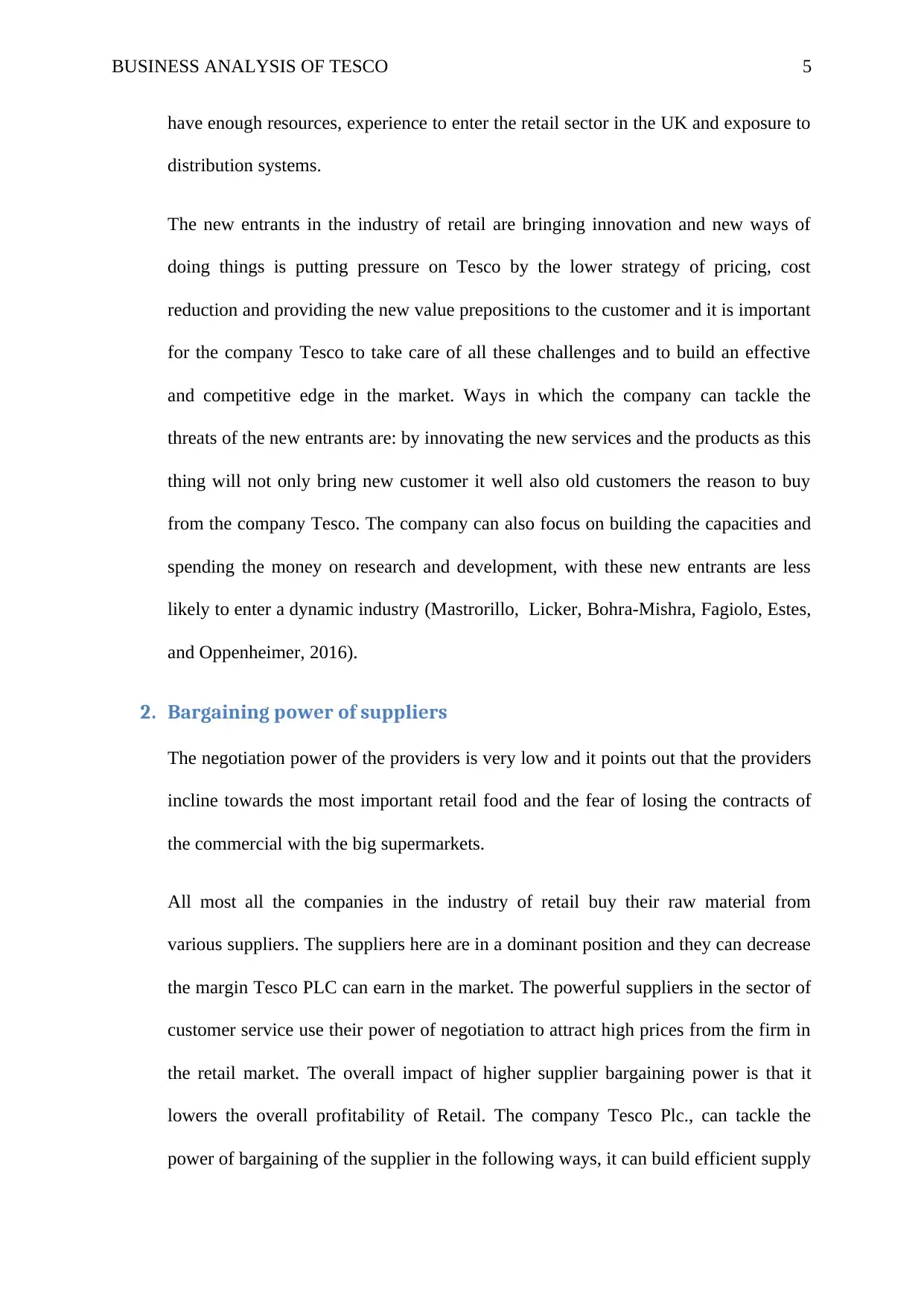
BUSINESS ANALYSIS OF TESCO 5
have enough resources, experience to enter the retail sector in the UK and exposure to
distribution systems.
The new entrants in the industry of retail are bringing innovation and new ways of
doing things is putting pressure on Tesco by the lower strategy of pricing, cost
reduction and providing the new value prepositions to the customer and it is important
for the company Tesco to take care of all these challenges and to build an effective
and competitive edge in the market. Ways in which the company can tackle the
threats of the new entrants are: by innovating the new services and the products as this
thing will not only bring new customer it well also old customers the reason to buy
from the company Tesco. The company can also focus on building the capacities and
spending the money on research and development, with these new entrants are less
likely to enter a dynamic industry (Mastrorillo, Licker, Bohra-Mishra, Fagiolo, Estes,
and Oppenheimer, 2016).
2. Bargaining power of suppliers
The negotiation power of the providers is very low and it points out that the providers
incline towards the most important retail food and the fear of losing the contracts of
the commercial with the big supermarkets.
All most all the companies in the industry of retail buy their raw material from
various suppliers. The suppliers here are in a dominant position and they can decrease
the margin Tesco PLC can earn in the market. The powerful suppliers in the sector of
customer service use their power of negotiation to attract high prices from the firm in
the retail market. The overall impact of higher supplier bargaining power is that it
lowers the overall profitability of Retail. The company Tesco Plc., can tackle the
power of bargaining of the supplier in the following ways, it can build efficient supply
have enough resources, experience to enter the retail sector in the UK and exposure to
distribution systems.
The new entrants in the industry of retail are bringing innovation and new ways of
doing things is putting pressure on Tesco by the lower strategy of pricing, cost
reduction and providing the new value prepositions to the customer and it is important
for the company Tesco to take care of all these challenges and to build an effective
and competitive edge in the market. Ways in which the company can tackle the
threats of the new entrants are: by innovating the new services and the products as this
thing will not only bring new customer it well also old customers the reason to buy
from the company Tesco. The company can also focus on building the capacities and
spending the money on research and development, with these new entrants are less
likely to enter a dynamic industry (Mastrorillo, Licker, Bohra-Mishra, Fagiolo, Estes,
and Oppenheimer, 2016).
2. Bargaining power of suppliers
The negotiation power of the providers is very low and it points out that the providers
incline towards the most important retail food and the fear of losing the contracts of
the commercial with the big supermarkets.
All most all the companies in the industry of retail buy their raw material from
various suppliers. The suppliers here are in a dominant position and they can decrease
the margin Tesco PLC can earn in the market. The powerful suppliers in the sector of
customer service use their power of negotiation to attract high prices from the firm in
the retail market. The overall impact of higher supplier bargaining power is that it
lowers the overall profitability of Retail. The company Tesco Plc., can tackle the
power of bargaining of the supplier in the following ways, it can build efficient supply
⊘ This is a preview!⊘
Do you want full access?
Subscribe today to unlock all pages.

Trusted by 1+ million students worldwide
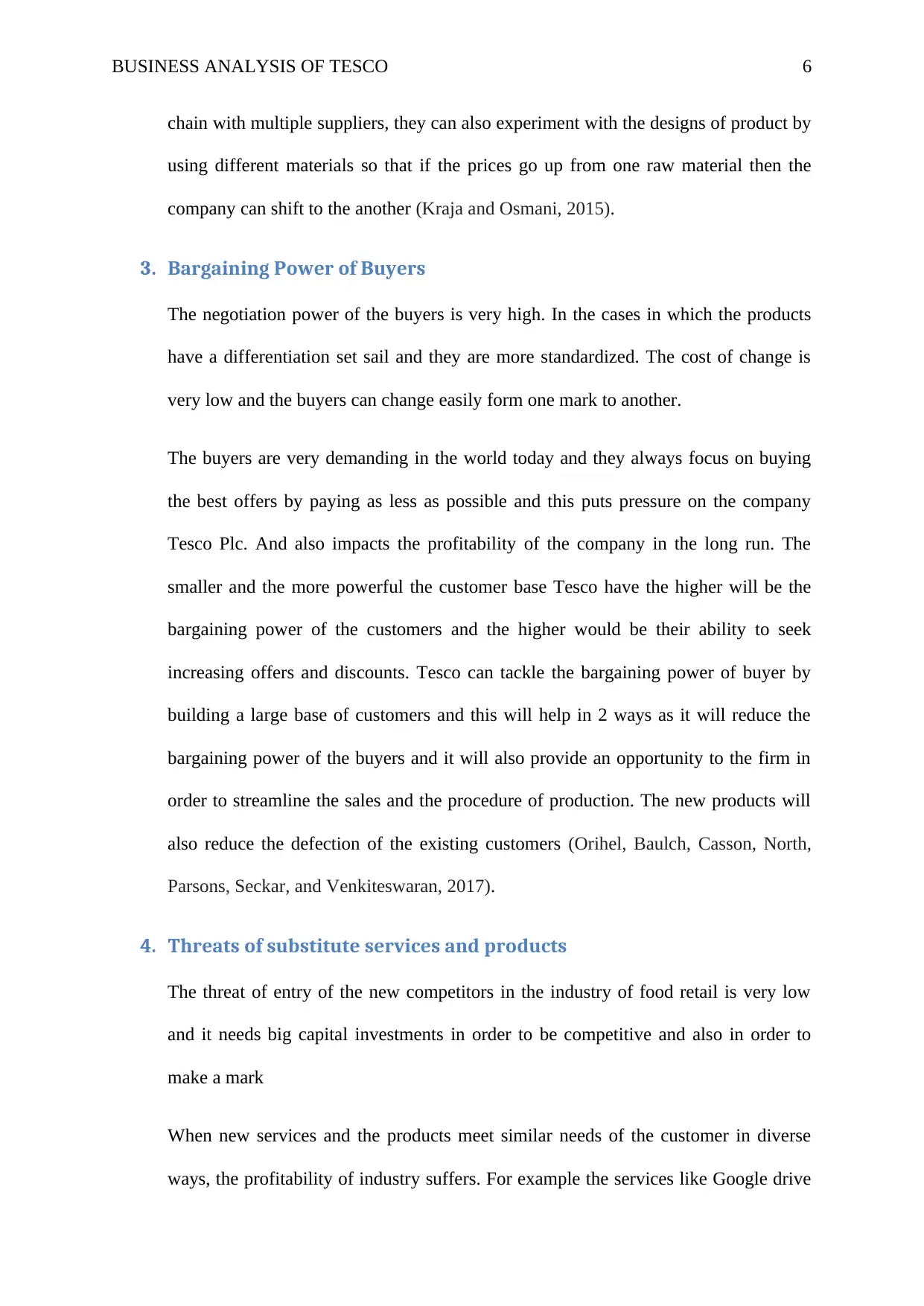
BUSINESS ANALYSIS OF TESCO 6
chain with multiple suppliers, they can also experiment with the designs of product by
using different materials so that if the prices go up from one raw material then the
company can shift to the another (Kraja and Osmani, 2015).
3. Bargaining Power of Buyers
The negotiation power of the buyers is very high. In the cases in which the products
have a differentiation set sail and they are more standardized. The cost of change is
very low and the buyers can change easily form one mark to another.
The buyers are very demanding in the world today and they always focus on buying
the best offers by paying as less as possible and this puts pressure on the company
Tesco Plc. And also impacts the profitability of the company in the long run. The
smaller and the more powerful the customer base Tesco have the higher will be the
bargaining power of the customers and the higher would be their ability to seek
increasing offers and discounts. Tesco can tackle the bargaining power of buyer by
building a large base of customers and this will help in 2 ways as it will reduce the
bargaining power of the buyers and it will also provide an opportunity to the firm in
order to streamline the sales and the procedure of production. The new products will
also reduce the defection of the existing customers (Orihel, Baulch, Casson, North,
Parsons, Seckar, and Venkiteswaran, 2017).
4. Threats of substitute services and products
The threat of entry of the new competitors in the industry of food retail is very low
and it needs big capital investments in order to be competitive and also in order to
make a mark
When new services and the products meet similar needs of the customer in diverse
ways, the profitability of industry suffers. For example the services like Google drive
chain with multiple suppliers, they can also experiment with the designs of product by
using different materials so that if the prices go up from one raw material then the
company can shift to the another (Kraja and Osmani, 2015).
3. Bargaining Power of Buyers
The negotiation power of the buyers is very high. In the cases in which the products
have a differentiation set sail and they are more standardized. The cost of change is
very low and the buyers can change easily form one mark to another.
The buyers are very demanding in the world today and they always focus on buying
the best offers by paying as less as possible and this puts pressure on the company
Tesco Plc. And also impacts the profitability of the company in the long run. The
smaller and the more powerful the customer base Tesco have the higher will be the
bargaining power of the customers and the higher would be their ability to seek
increasing offers and discounts. Tesco can tackle the bargaining power of buyer by
building a large base of customers and this will help in 2 ways as it will reduce the
bargaining power of the buyers and it will also provide an opportunity to the firm in
order to streamline the sales and the procedure of production. The new products will
also reduce the defection of the existing customers (Orihel, Baulch, Casson, North,
Parsons, Seckar, and Venkiteswaran, 2017).
4. Threats of substitute services and products
The threat of entry of the new competitors in the industry of food retail is very low
and it needs big capital investments in order to be competitive and also in order to
make a mark
When new services and the products meet similar needs of the customer in diverse
ways, the profitability of industry suffers. For example the services like Google drive
Paraphrase This Document
Need a fresh take? Get an instant paraphrase of this document with our AI Paraphraser
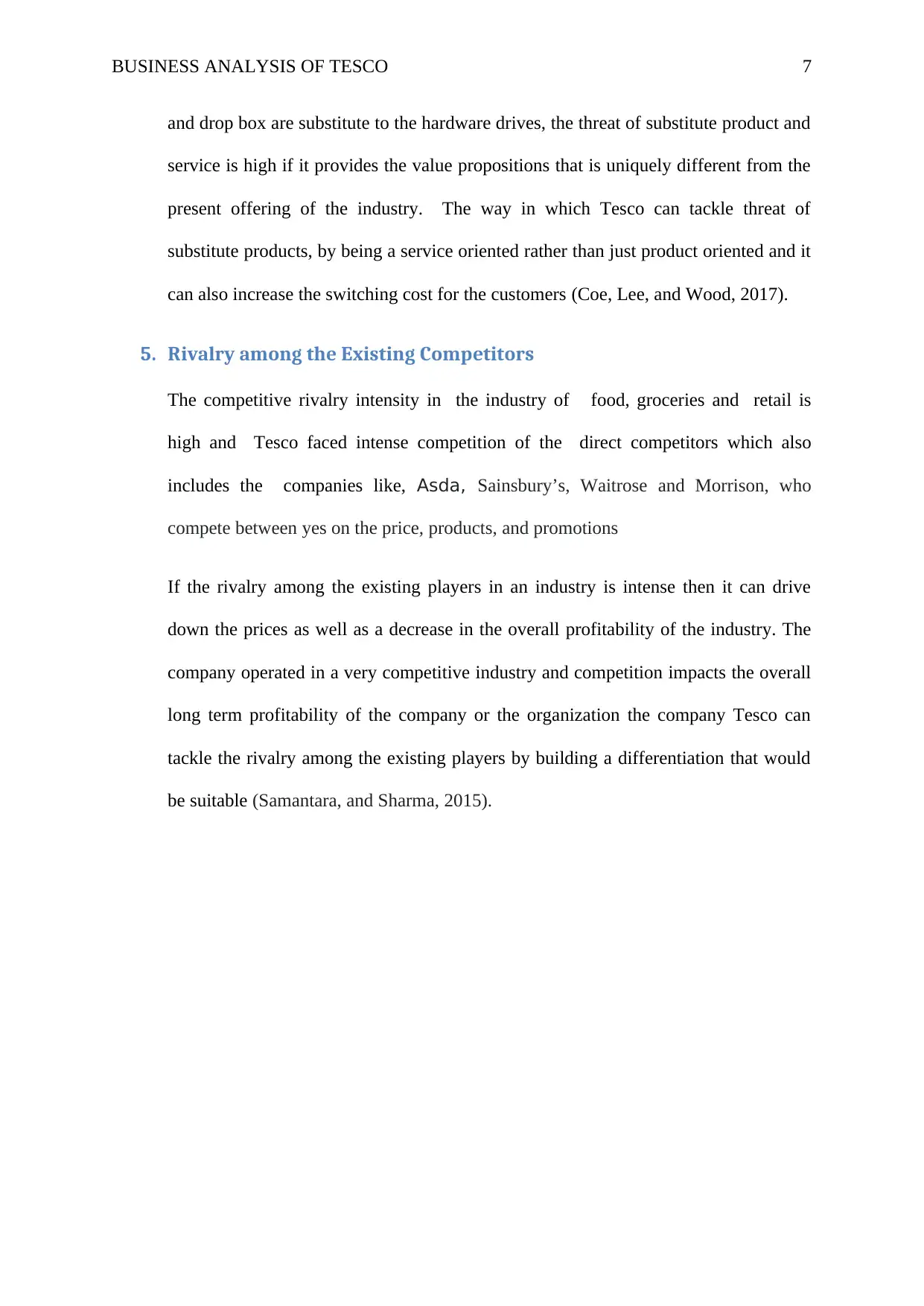
BUSINESS ANALYSIS OF TESCO 7
and drop box are substitute to the hardware drives, the threat of substitute product and
service is high if it provides the value propositions that is uniquely different from the
present offering of the industry. The way in which Tesco can tackle threat of
substitute products, by being a service oriented rather than just product oriented and it
can also increase the switching cost for the customers (Coe, Lee, and Wood, 2017).
5. Rivalry among the Existing Competitors
The competitive rivalry intensity in the industry of food, groceries and retail is
high and Tesco faced intense competition of the direct competitors which also
includes the companies like, Asda, Sainsbury’s, Waitrose and Morrison, who
compete between yes on the price, products, and promotions
If the rivalry among the existing players in an industry is intense then it can drive
down the prices as well as a decrease in the overall profitability of the industry. The
company operated in a very competitive industry and competition impacts the overall
long term profitability of the company or the organization the company Tesco can
tackle the rivalry among the existing players by building a differentiation that would
be suitable (Samantara, and Sharma, 2015).
and drop box are substitute to the hardware drives, the threat of substitute product and
service is high if it provides the value propositions that is uniquely different from the
present offering of the industry. The way in which Tesco can tackle threat of
substitute products, by being a service oriented rather than just product oriented and it
can also increase the switching cost for the customers (Coe, Lee, and Wood, 2017).
5. Rivalry among the Existing Competitors
The competitive rivalry intensity in the industry of food, groceries and retail is
high and Tesco faced intense competition of the direct competitors which also
includes the companies like, Asda, Sainsbury’s, Waitrose and Morrison, who
compete between yes on the price, products, and promotions
If the rivalry among the existing players in an industry is intense then it can drive
down the prices as well as a decrease in the overall profitability of the industry. The
company operated in a very competitive industry and competition impacts the overall
long term profitability of the company or the organization the company Tesco can
tackle the rivalry among the existing players by building a differentiation that would
be suitable (Samantara, and Sharma, 2015).
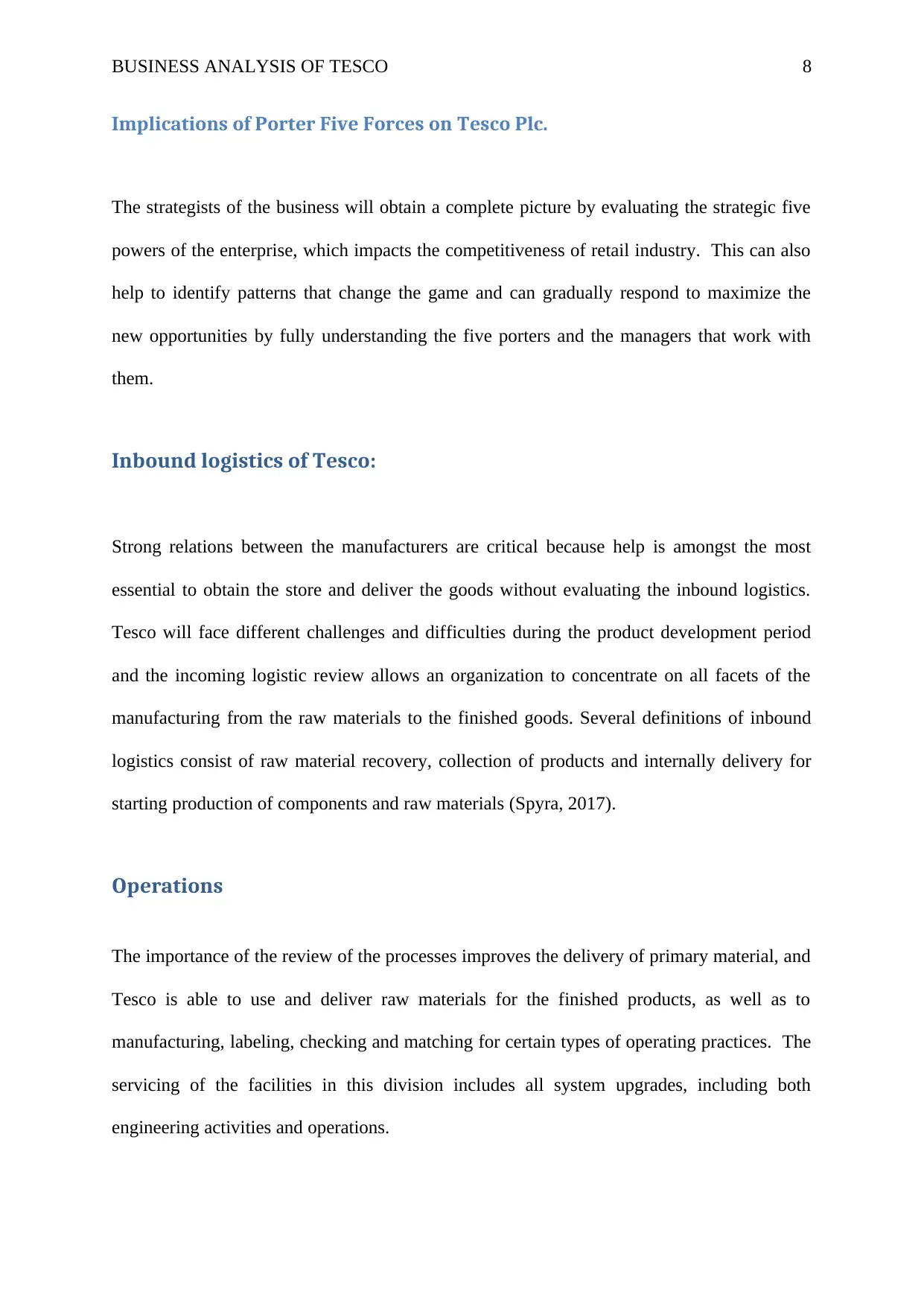
BUSINESS ANALYSIS OF TESCO 8
Implications of Porter Five Forces on Tesco Plc.
The strategists of the business will obtain a complete picture by evaluating the strategic five
powers of the enterprise, which impacts the competitiveness of retail industry. This can also
help to identify patterns that change the game and can gradually respond to maximize the
new opportunities by fully understanding the five porters and the managers that work with
them.
Inbound logistics of Tesco:
Strong relations between the manufacturers are critical because help is amongst the most
essential to obtain the store and deliver the goods without evaluating the inbound logistics.
Tesco will face different challenges and difficulties during the product development period
and the incoming logistic review allows an organization to concentrate on all facets of the
manufacturing from the raw materials to the finished goods. Several definitions of inbound
logistics consist of raw material recovery, collection of products and internally delivery for
starting production of components and raw materials (Spyra, 2017).
Operations
The importance of the review of the processes improves the delivery of primary material, and
Tesco is able to use and deliver raw materials for the finished products, as well as to
manufacturing, labeling, checking and matching for certain types of operating practices. The
servicing of the facilities in this division includes all system upgrades, including both
engineering activities and operations.
Implications of Porter Five Forces on Tesco Plc.
The strategists of the business will obtain a complete picture by evaluating the strategic five
powers of the enterprise, which impacts the competitiveness of retail industry. This can also
help to identify patterns that change the game and can gradually respond to maximize the
new opportunities by fully understanding the five porters and the managers that work with
them.
Inbound logistics of Tesco:
Strong relations between the manufacturers are critical because help is amongst the most
essential to obtain the store and deliver the goods without evaluating the inbound logistics.
Tesco will face different challenges and difficulties during the product development period
and the incoming logistic review allows an organization to concentrate on all facets of the
manufacturing from the raw materials to the finished goods. Several definitions of inbound
logistics consist of raw material recovery, collection of products and internally delivery for
starting production of components and raw materials (Spyra, 2017).
Operations
The importance of the review of the processes improves the delivery of primary material, and
Tesco is able to use and deliver raw materials for the finished products, as well as to
manufacturing, labeling, checking and matching for certain types of operating practices. The
servicing of the facilities in this division includes all system upgrades, including both
engineering activities and operations.
⊘ This is a preview!⊘
Do you want full access?
Subscribe today to unlock all pages.

Trusted by 1+ million students worldwide
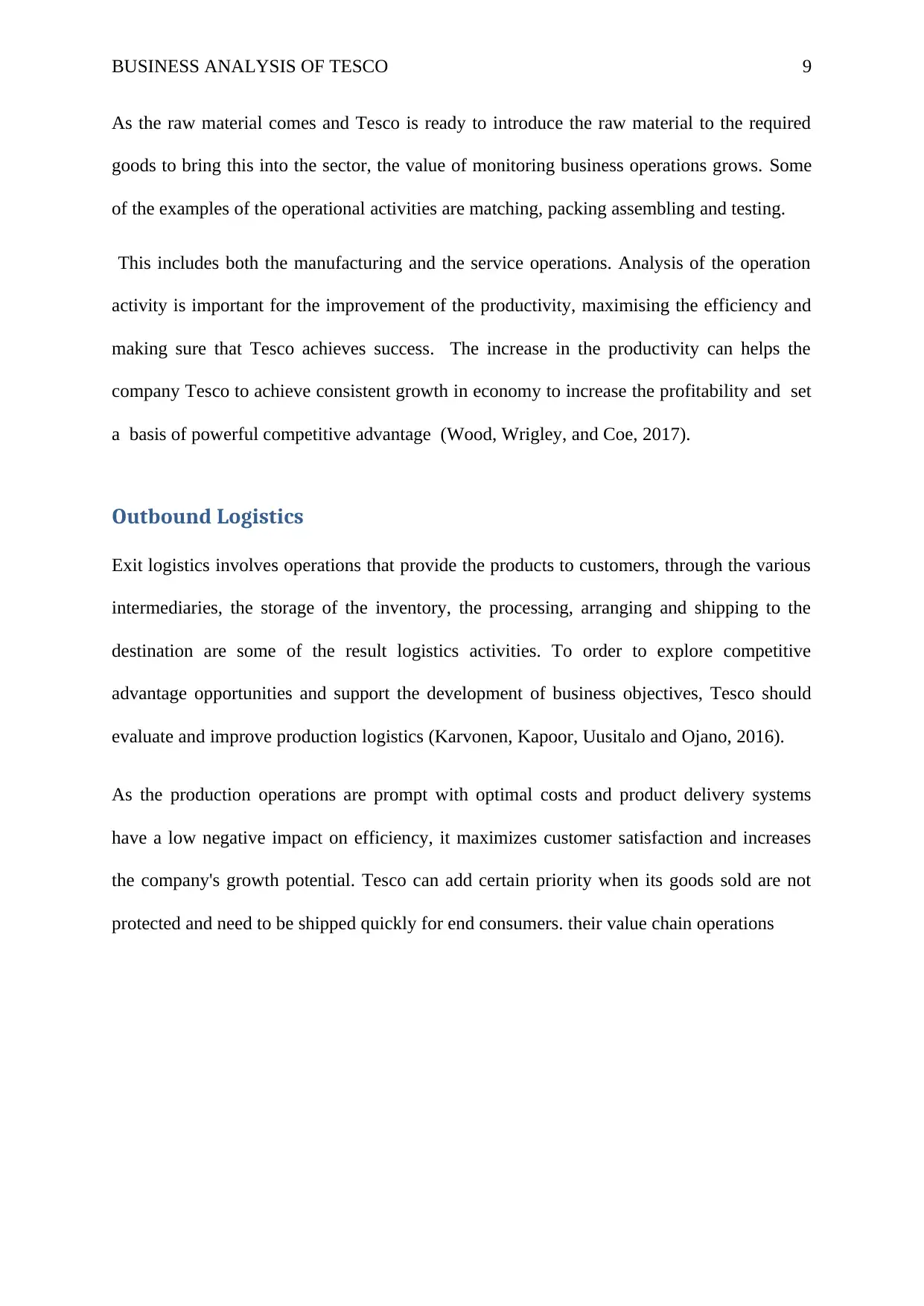
BUSINESS ANALYSIS OF TESCO 9
As the raw material comes and Tesco is ready to introduce the raw material to the required
goods to bring this into the sector, the value of monitoring business operations grows. Some
of the examples of the operational activities are matching, packing assembling and testing.
This includes both the manufacturing and the service operations. Analysis of the operation
activity is important for the improvement of the productivity, maximising the efficiency and
making sure that Tesco achieves success. The increase in the productivity can helps the
company Tesco to achieve consistent growth in economy to increase the profitability and set
a basis of powerful competitive advantage (Wood, Wrigley, and Coe, 2017).
Outbound Logistics
Exit logistics involves operations that provide the products to customers, through the various
intermediaries, the storage of the inventory, the processing, arranging and shipping to the
destination are some of the result logistics activities. To order to explore competitive
advantage opportunities and support the development of business objectives, Tesco should
evaluate and improve production logistics (Karvonen, Kapoor, Uusitalo and Ojano, 2016).
As the production operations are prompt with optimal costs and product delivery systems
have a low negative impact on efficiency, it maximizes customer satisfaction and increases
the company's growth potential. Tesco can add certain priority when its goods sold are not
protected and need to be shipped quickly for end consumers. their value chain operations
As the raw material comes and Tesco is ready to introduce the raw material to the required
goods to bring this into the sector, the value of monitoring business operations grows. Some
of the examples of the operational activities are matching, packing assembling and testing.
This includes both the manufacturing and the service operations. Analysis of the operation
activity is important for the improvement of the productivity, maximising the efficiency and
making sure that Tesco achieves success. The increase in the productivity can helps the
company Tesco to achieve consistent growth in economy to increase the profitability and set
a basis of powerful competitive advantage (Wood, Wrigley, and Coe, 2017).
Outbound Logistics
Exit logistics involves operations that provide the products to customers, through the various
intermediaries, the storage of the inventory, the processing, arranging and shipping to the
destination are some of the result logistics activities. To order to explore competitive
advantage opportunities and support the development of business objectives, Tesco should
evaluate and improve production logistics (Karvonen, Kapoor, Uusitalo and Ojano, 2016).
As the production operations are prompt with optimal costs and product delivery systems
have a low negative impact on efficiency, it maximizes customer satisfaction and increases
the company's growth potential. Tesco can add certain priority when its goods sold are not
protected and need to be shipped quickly for end consumers. their value chain operations
Paraphrase This Document
Need a fresh take? Get an instant paraphrase of this document with our AI Paraphraser
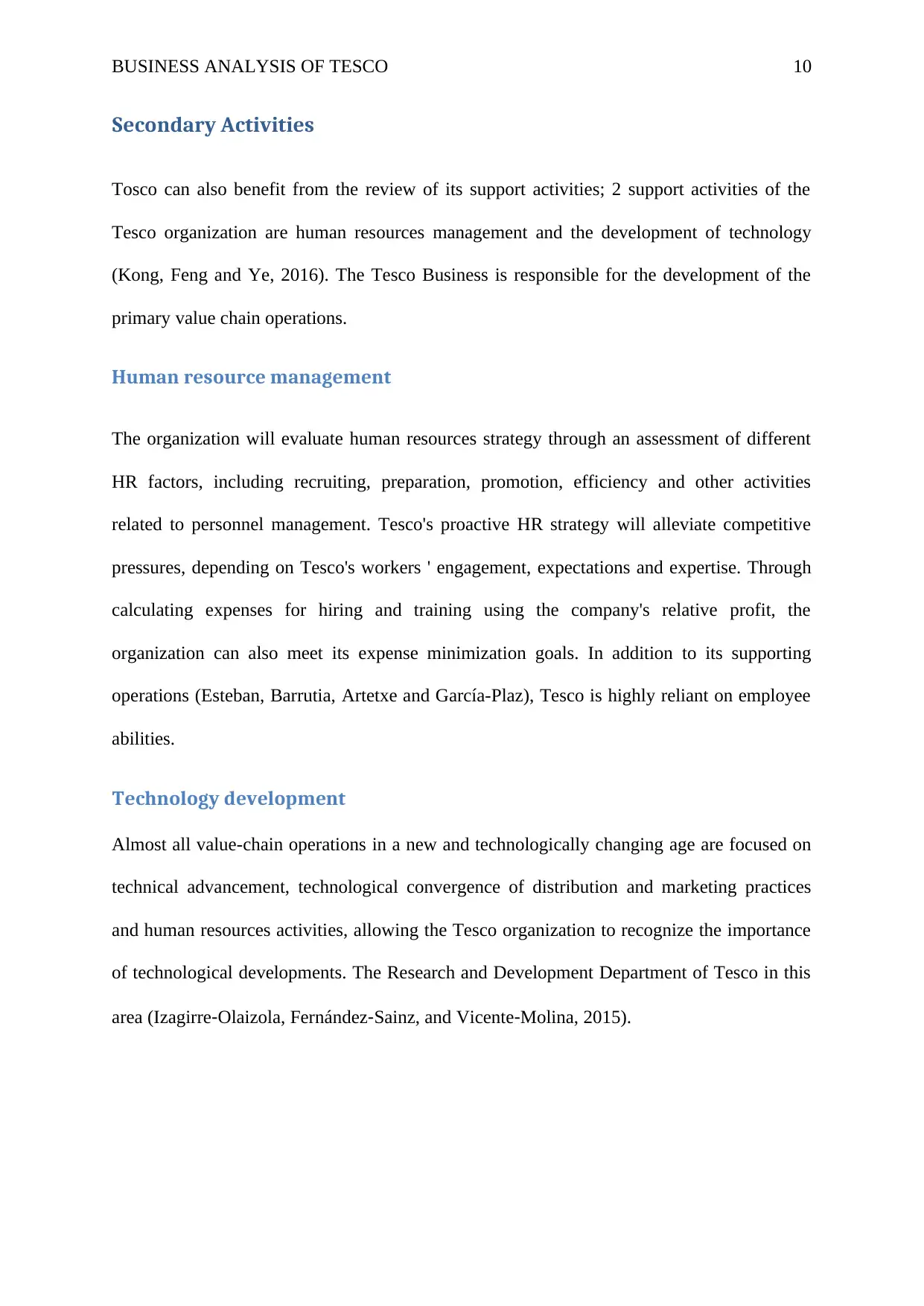
BUSINESS ANALYSIS OF TESCO 10
Secondary Activities
Tosco can also benefit from the review of its support activities; 2 support activities of the
Tesco organization are human resources management and the development of technology
(Kong, Feng and Ye, 2016). The Tesco Business is responsible for the development of the
primary value chain operations.
Human resource management
The organization will evaluate human resources strategy through an assessment of different
HR factors, including recruiting, preparation, promotion, efficiency and other activities
related to personnel management. Tesco's proactive HR strategy will alleviate competitive
pressures, depending on Tesco's workers ' engagement, expectations and expertise. Through
calculating expenses for hiring and training using the company's relative profit, the
organization can also meet its expense minimization goals. In addition to its supporting
operations (Esteban, Barrutia, Artetxe and García-Plaz), Tesco is highly reliant on employee
abilities.
Technology development
Almost all value-chain operations in a new and technologically changing age are focused on
technical advancement, technological convergence of distribution and marketing practices
and human resources activities, allowing the Tesco organization to recognize the importance
of technological developments. The Research and Development Department of Tesco in this
area (Izagirre‐Olaizola, Fernández‐Sainz, and Vicente‐Molina, 2015).
Secondary Activities
Tosco can also benefit from the review of its support activities; 2 support activities of the
Tesco organization are human resources management and the development of technology
(Kong, Feng and Ye, 2016). The Tesco Business is responsible for the development of the
primary value chain operations.
Human resource management
The organization will evaluate human resources strategy through an assessment of different
HR factors, including recruiting, preparation, promotion, efficiency and other activities
related to personnel management. Tesco's proactive HR strategy will alleviate competitive
pressures, depending on Tesco's workers ' engagement, expectations and expertise. Through
calculating expenses for hiring and training using the company's relative profit, the
organization can also meet its expense minimization goals. In addition to its supporting
operations (Esteban, Barrutia, Artetxe and García-Plaz), Tesco is highly reliant on employee
abilities.
Technology development
Almost all value-chain operations in a new and technologically changing age are focused on
technical advancement, technological convergence of distribution and marketing practices
and human resources activities, allowing the Tesco organization to recognize the importance
of technological developments. The Research and Development Department of Tesco in this
area (Izagirre‐Olaizola, Fernández‐Sainz, and Vicente‐Molina, 2015).
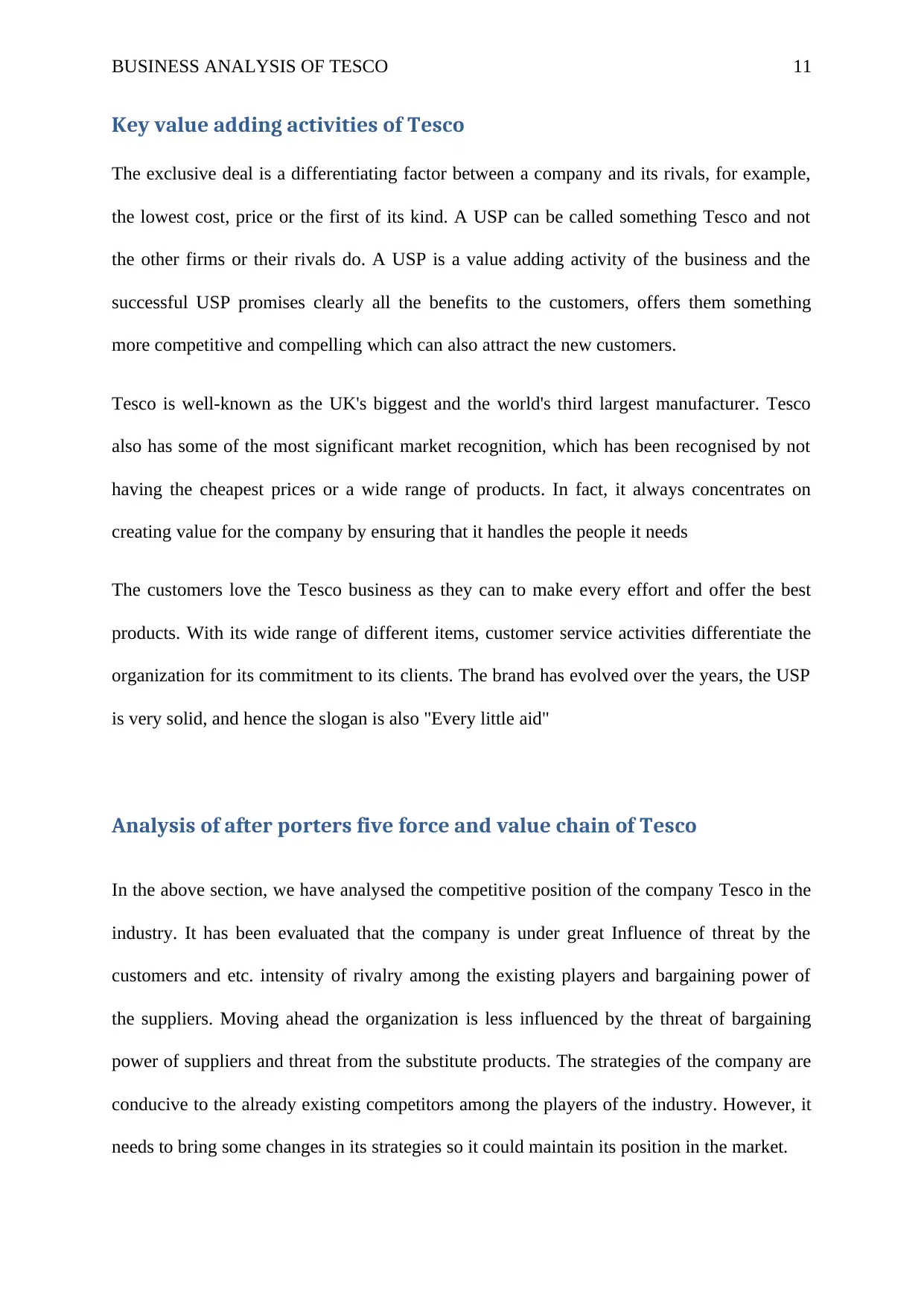
BUSINESS ANALYSIS OF TESCO 11
Key value adding activities of Tesco
The exclusive deal is a differentiating factor between a company and its rivals, for example,
the lowest cost, price or the first of its kind. A USP can be called something Tesco and not
the other firms or their rivals do. A USP is a value adding activity of the business and the
successful USP promises clearly all the benefits to the customers, offers them something
more competitive and compelling which can also attract the new customers.
Tesco is well-known as the UK's biggest and the world's third largest manufacturer. Tesco
also has some of the most significant market recognition, which has been recognised by not
having the cheapest prices or a wide range of products. In fact, it always concentrates on
creating value for the company by ensuring that it handles the people it needs
The customers love the Tesco business as they can to make every effort and offer the best
products. With its wide range of different items, customer service activities differentiate the
organization for its commitment to its clients. The brand has evolved over the years, the USP
is very solid, and hence the slogan is also "Every little aid"
Analysis of after porters five force and value chain of Tesco
In the above section, we have analysed the competitive position of the company Tesco in the
industry. It has been evaluated that the company is under great Influence of threat by the
customers and etc. intensity of rivalry among the existing players and bargaining power of
the suppliers. Moving ahead the organization is less influenced by the threat of bargaining
power of suppliers and threat from the substitute products. The strategies of the company are
conducive to the already existing competitors among the players of the industry. However, it
needs to bring some changes in its strategies so it could maintain its position in the market.
Key value adding activities of Tesco
The exclusive deal is a differentiating factor between a company and its rivals, for example,
the lowest cost, price or the first of its kind. A USP can be called something Tesco and not
the other firms or their rivals do. A USP is a value adding activity of the business and the
successful USP promises clearly all the benefits to the customers, offers them something
more competitive and compelling which can also attract the new customers.
Tesco is well-known as the UK's biggest and the world's third largest manufacturer. Tesco
also has some of the most significant market recognition, which has been recognised by not
having the cheapest prices or a wide range of products. In fact, it always concentrates on
creating value for the company by ensuring that it handles the people it needs
The customers love the Tesco business as they can to make every effort and offer the best
products. With its wide range of different items, customer service activities differentiate the
organization for its commitment to its clients. The brand has evolved over the years, the USP
is very solid, and hence the slogan is also "Every little aid"
Analysis of after porters five force and value chain of Tesco
In the above section, we have analysed the competitive position of the company Tesco in the
industry. It has been evaluated that the company is under great Influence of threat by the
customers and etc. intensity of rivalry among the existing players and bargaining power of
the suppliers. Moving ahead the organization is less influenced by the threat of bargaining
power of suppliers and threat from the substitute products. The strategies of the company are
conducive to the already existing competitors among the players of the industry. However, it
needs to bring some changes in its strategies so it could maintain its position in the market.
⊘ This is a preview!⊘
Do you want full access?
Subscribe today to unlock all pages.

Trusted by 1+ million students worldwide
1 out of 18
Related Documents
Your All-in-One AI-Powered Toolkit for Academic Success.
+13062052269
info@desklib.com
Available 24*7 on WhatsApp / Email
![[object Object]](/_next/static/media/star-bottom.7253800d.svg)
Unlock your academic potential
Copyright © 2020–2025 A2Z Services. All Rights Reserved. Developed and managed by ZUCOL.





